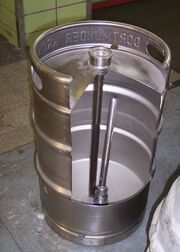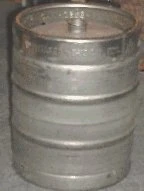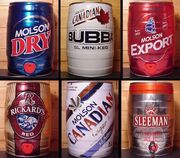No edit summary |
XD1 (Message Wall | contribs) m (clean up, typos fixed: recycleable → recyclable) |
||
| Line 39: | Line 39: | ||
|8.5 |
|8.5 |
||
| - |
| - |
||
| − | |Mini Keg / [[Bubba]] (single-use/ |
+ | |Mini Keg / [[Bubba]] (single-use/recyclable) |
|- |
|- |
||
|5 |
|5 |
||
| Line 92: | Line 92: | ||
===Specifications for a U.S. 1/2 barrel keg=== |
===Specifications for a U.S. 1/2 barrel keg=== |
||
| − | Accepted specifications for a standard keg are: |
+ | Accepted specifications for a standard keg are:<ref>[http://waylandworks.com/draftbeer.htm Retailers Guide to Draft Beer Dispensing (accessed 2007-10-29)]</ref> |
{|class="wikitable" |
{|class="wikitable" |
||
| Line 133: | Line 133: | ||
==Other types of kegs== |
==Other types of kegs== |
||
| − | === |
+ | === Mini keg === |
[[Image:AssortedMiniKegs.jpg|right|thumb|Assorted Canadian Bubba Minikegs]] |
[[Image:AssortedMiniKegs.jpg|right|thumb|Assorted Canadian Bubba Minikegs]] |
||
| Line 142: | Line 142: | ||
Another type of mini keg is the "beer ball", a disposable plastic ball that usually holds around 5.2 gallons, roughly the equivalent of fifty five twelve-ounce beers, though they can also be found in a smaller, 3.8 gallon size. Like kegs, it is necessary to tap the ball before the beer inside it can be served. |
Another type of mini keg is the "beer ball", a disposable plastic ball that usually holds around 5.2 gallons, roughly the equivalent of fifty five twelve-ounce beers, though they can also be found in a smaller, 3.8 gallon size. Like kegs, it is necessary to tap the ball before the beer inside it can be served. |
||
| − | === |
+ | === Pony keg === |
A '''[[pony keg]]''' is a beer vessel containing 7.75 U.S. gallons (29.33 liters) of fluid. It is half the size of the standard beer keg and equivalent to a quarter of a barrel. It will serve roughly 82 twelve ounce cups. The shape of a pony keg resembles that of a full-sized keg, while being much easier to move manually. However, it shares many inconveniences with the bigger kegs, such as: often requiring a deposit when purchased; needing a tap to serve the contents; and posing difficulties in determining the amount of beer remaining (weighing the keg or observing its buoyancy are common techniques). Despite this, a pony keg can be a cheap way to provide beer for a medium-sized party. |
A '''[[pony keg]]''' is a beer vessel containing 7.75 U.S. gallons (29.33 liters) of fluid. It is half the size of the standard beer keg and equivalent to a quarter of a barrel. It will serve roughly 82 twelve ounce cups. The shape of a pony keg resembles that of a full-sized keg, while being much easier to move manually. However, it shares many inconveniences with the bigger kegs, such as: often requiring a deposit when purchased; needing a tap to serve the contents; and posing difficulties in determining the amount of beer remaining (weighing the keg or observing its buoyancy are common techniques). Despite this, a pony keg can be a cheap way to provide beer for a medium-sized party. |
||
Revision as of 16:35, 22 March 2013

A 15.5 US gallon keg, cutaway
A keg is a cylindrical container, usually constructed of aluminum, steel or wood. It is commonly used to store, transport, and serve beer. Other alcoholic or non-alcoholic drinks, carbonated or non-carbonated, may be housed in a keg as well. Such liquids are generally kept under pressure.
Formerly a keg was a small barrel made by a cooper used to transport items such as nails and gunpowder.[1]
Size
Since keg sizes are standardized, the keg can be used as a standard unit of measure for liquid volumes. This size standard, however, varies from country to country, with many countries using the metric system rather than U.S. gallons.

A typical keg (half-barrel) with single opening in the center of the top end
A full keg is a 15.5 U.S. gallon barrel, routinely called a half-barrel. A half keg or pony keg is therefore called a quarter-barrel and has a volume of 7.75 U.S. gallons. Generally a keg is a vessel smaller than a barrel; thus, it is 30 gallons or smaller.[2]
In the U.S. the terms half-barrel and quarter-barrel are derived from the fact that a U.S. beer barrel is legally defined as being equal to 31 U.S. gallons (note that this is not the same volume as some other units commonly known as barrels). A 15.5 U.S. gallon keg is also equal to:
- 12.69 Imperial gallons
- 58.67 liters
- 103.25 Imperial pints
- 124 U.S. pints
- 165 twelve fluid ounce drinks
- About 6.88 24-unit cases of 12 fl oz cans.
- 1984 fluid ounces
In European countries where the metric system is used, kegs come in 25 and 50 liters as a standard. It is common to refer to the size not in liters but in beers. The standard beer size is .5 liters so a 50 liter keg would be 100 beers.
However, beer kegs can come in many sizes:
| Size (US gal) | Size (liters) | No. of 12 fl oz drinks | No. of 16 fl oz drinks | No. of 20 fl oz drinks | Weight of full keg (lb) | Also known as |
|---|---|---|---|---|---|---|
| 1.32 | 5 | 14 | 10.6 | 8.5 | - | Mini Keg / Bubba (single-use/recyclable) |
| 5 | 18.9 | 53 | 40 | 32 | 55-60 | Soda syrup / Cornelius kegs / Home Brew |
| 5.23 | 19.8 | 56 | 42 | 33 | - | Sixth Barrel |
| 6.6 | 25 | 70 | 50.25 | 42 | - | "Half Barrel" (Europe) |
| 7.75 | 29.3 | 82 | 62 | 49 | 90 | Quarter Barrel / Pony Keg |
| 13.2 | 50 | 140 | 105 | 84 | - | Import Keg (standard European "Barrel") |
| 15.5 | 58.7 | 165 | 124 | 99 | 140 - 170 | Half Barrel / Full Keg |
Specifications for a U.S. 1/2 barrel keg
Accepted specifications for a standard keg are:[3]
| Height of keg | 23.3 inches |
| Diameter of keg | 16.1–17.15627 inches |
| Contents | 1984.0 U.S. fluid ounces |
| 15.5 U.S. gallons | |
| 12.91 imp. gallons | |
| 58.7 liters | |
| Full keg weight | 160.5 pounds (72.8 kg) |
| Empty keg weight | 29.7 pounds (13.5 kg) |
| Beer weight | 130.8 pounds (59.3 kg) |
| 24×12 fl oz case equivalent | 6.9 cases |
| 12 fl oz servings | 165.333 |
| 16 fl oz (1 U.S. pint) servings | 124 |
Differences between a keg and a cask
In brewing parlance, a keg is different from a cask. The keg is built with a downtube located in its center with a valve to force gases out when filling and air in when dispensing. Kegs are artificially pressurized after fermentation with carbon dioxide or a mixture of carbon dioxide and nitrogen gas. A cask has a tap hole near the edge of the top, and a spile hole on the side used for conditioning the unfiltered and unpasteurized beer. Casks are simply gravity-fed for the dispensing of liquids. Additionally, kegs have a simple concave bottom whereas a cask is flat on the bottom. The concavity allows for sediment to be captured away from the flow pipe in the keg. Lastly, kegs have straight sides, unlike the traditional barrel or cask shape.
Other types of kegs
Mini keg

Assorted Canadian Bubba Minikegs
The mini keg is a 5-liter keg produced for retail sales. Some brands come with a spout and pour from the bottom via gravity, while others may use a low cost pressurized tap. Mini kegs are typically not returned to the manufacturer for cleaning and refilling. The kegs, being made of aluminum, may be recycled.
In Canada, Molson brewery dubbed the mini keg "Bubba." Much like other brand names, the name is now generally applied to all 5-liter mini kegs in Canada. This might cause confusion, as a company called Bubba Keg is established in the U.S., and appears to not be associated with Molson.
Another type of mini keg is the "beer ball", a disposable plastic ball that usually holds around 5.2 gallons, roughly the equivalent of fifty five twelve-ounce beers, though they can also be found in a smaller, 3.8 gallon size. Like kegs, it is necessary to tap the ball before the beer inside it can be served.
Pony keg
A pony keg is a beer vessel containing 7.75 U.S. gallons (29.33 liters) of fluid. It is half the size of the standard beer keg and equivalent to a quarter of a barrel. It will serve roughly 82 twelve ounce cups. The shape of a pony keg resembles that of a full-sized keg, while being much easier to move manually. However, it shares many inconveniences with the bigger kegs, such as: often requiring a deposit when purchased; needing a tap to serve the contents; and posing difficulties in determining the amount of beer remaining (weighing the keg or observing its buoyancy are common techniques). Despite this, a pony keg can be a cheap way to provide beer for a medium-sized party.
See also
- Barrel
- Firkin
- Cask ale
- Draft beer
References
Notes
External links
- "Definition of a Keg"
- "Parts of a Keg"
- "Smaller home brew kegs"
- How to Tap a Keg - A wikiHow article
- Keg Beer Dispensing Articles and Education
- OSHA: Beverage Delivery Ergonomics
- Micromatic FAQ about Beer
- Keg FAQs Frequently asked questions on how to set up a keg of beer and how to maintain keg tapping equipment.
- Beer Brand / Keg Coupler Listing Reference Guide: Match the beer brand with the correct keg coupler (keg tap) or keg pump.

|
This page uses content from Wikipedia. The original article was at Keg. The list of authors can be seen in the page history. As with Beer Wiki, the text of Wikipedia is available under the Creative Commons Attribution-Share Alike License 3.0. |